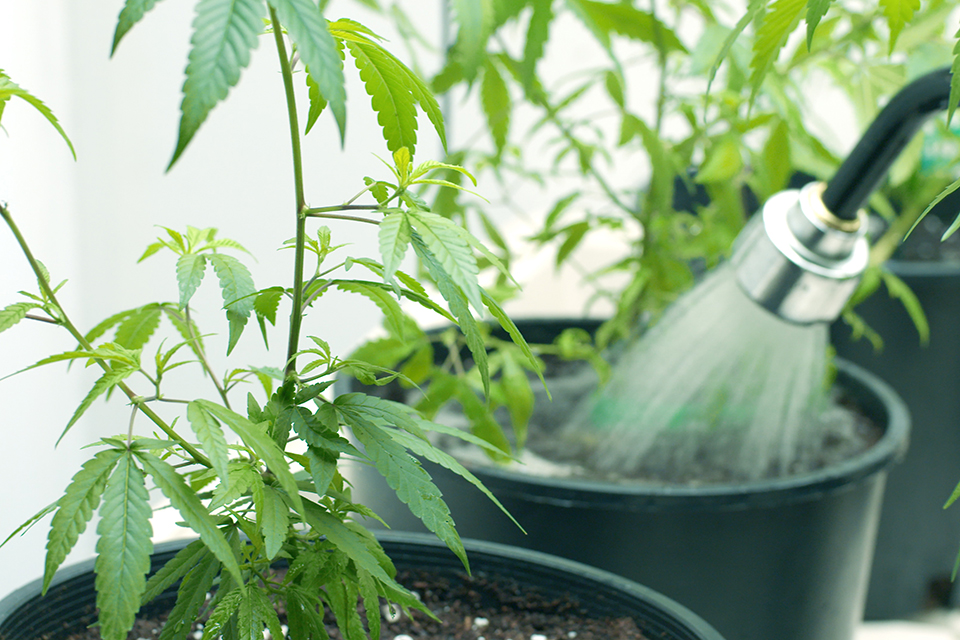
Flushing cannabis removes excess nutrients and built-up salts from the growing medium before harvest, improving the smoothness, flavor, and overall quality of the final product. Over time, fertilizers and additives accumulate in the soil or hydroponic system. This can lead to harsh-tasting buds with an unpleasant chemical aftertaste. Properly flushed plants produce a cleaner, more aromatic smoke with improved burnability.
For home cannabis growers in the USA, understanding when and how to flush cannabis leads to a high-quality harvest with fewer residual nutrients in the final product. The process involves using plain water to rinse out accumulated minerals and fertilizers, allowing the plant to use up its remaining stored nutrients before harvest. However, effective flushing requires precise timing—flushing too early can lead to nutrient deficiencies, while flushing too late may not remove enough excess buildup.
At Kind Seed Co., we provide expert guidance to help home growers navigate the nuances of effective flushing techniques. The best approach depends on the growing medium—soil, coco coir, or hydroponics—all of which require different flushing durations and methods. Learning the right way to flush cannabis ensures buds reach their full potential, delivering a smoother smoking experience with enhanced flavor and aroma.
Why Flushing Cannabis is Critical for a Healthy Grow
Flushing cannabis at the right stage of growth helps remove excess salts, minerals, and synthetic nutrients from the plant’s system, leading to a cleaner final product. When fertilizers accumulate in the growing medium, they can alter the flavor, aroma, and burnability of dried cannabis. Flushing allows the plant to metabolize and use up stored nutrients, providing a smoother, more enjoyable smoking experience.
Beyond improving taste and aroma, flushing can also contribute to plant health. When cannabis nears the end of its life cycle, excess nutrients are no longer necessary, and flushing prevents the risk of over-fertilization. This process helps eliminate any remaining residual chemicals that may cause harshness when smoking or vaporizing the buds.
Some growers believe flushing is unnecessary, arguing that plants naturally use excess nutrients toward the end of their life cycle. However, skipping this step can leave behind unwanted compounds that affect the final quality of the flower. Flushing gives growers greater control over their final product, ensuring a clean, smooth smoking experience every time.
When to Flush Cannabis Plants
Flushing cannabis at the right time ensures plants have used up excess nutrients before harvest, resulting in smoother-burning, flavorful buds. The ideal timing depends on the growing medium and the strain’s flowering cycle.
General Guidelines for When to Flush:
- Soil Grows: Flush one to two weeks before harvest to gradually allow the plant to process stored nutrients.
- Coco Coir: Flush five to seven days before harvest since coco retains fewer nutrients than soil.
- Hydroponics: Flush three to five days before harvest due to the direct absorption of nutrients in water-based systems.
Signs That Indicate It’s Time to Flush:
- Yellowing Leaves: The lower fan leaves fade as the plant consumes stored nutrients.
- Buds Ripening: Pistils darken, and trichomes turn cloudy or amber.
- Tapering Water Needs: Plants take up less water as they approach the end of their cycle.
How to Flush Cannabis: Step-by-Step Process
Flushing cannabis involves running clean, pH-balanced water through the growing medium to remove built-up salts and excess nutrients. Gradually completing the process prevents shocking the plant while allowing it to use stored nutrients efficiently.
1. Preparing for the Flush
Before starting the flush, gather the necessary materials and ensure your setup is ready for a smooth process.
What You Need:
- pH meter to test water levels
- Clean, dechlorinated water with a balanced pH
- Runoff trays or drainage system for excess water
- Optional: TDS (Total Dissolved Solids) meter to measure nutrient buildup
Setting Up for a Successful Flush:
- Check pH Levels: The ideal pH for flushing is 6.0-6.8 for soil and 5.5-6.5 for hydroponics or coco coir.
- Use Pure Water: Tap water should be left out for 24 hours to let chlorine evaporate, or use filtered/distilled water.
- Prepare for Drainage: Ensure runoff has a way to exit, preventing stagnant water in pots or hydro setups.
2. Executing the Flush
Once prepared, begin flushing the plants by gradually introducing clean water to the growing medium.
Step-by-Step Process:
- Step #1: Slowly Saturate the Soil or Medium: Water until runoff drains from the bottom.
Step #2: Monitor Runoff Clarity: Initially, runoff may appear discolored due to nutrient buildup. - Step #3: Adjust Watering Schedule: Flushed plants may need less frequent watering. Avoid overwatering while they process the remaining nutrients.
3. Monitoring Plant Response
After flushing, cannabis plants show visible signs of how well the process is working.
What to Look For:
- Gradual Yellowing of Leaves: This indicates the plant is consuming stored nutrients, a normal sign during flushing.
- Runoff EC/TDS Readings: A drop in PPM (parts per million) signals successful nutrient removal.
- No Signs of Overwatering: Leaves should stay firm; drooping suggests too much water too quickly.
Carefully observing plant response helps fine-tune the flushing process, ensuring the best results without unnecessary stress.
Common Mistakes to Avoid When Flushing
Flushing cannabis is a simple process, but mistakes can impact plant health and bud quality. Avoid these common errors:
1. Flushing at the Wrong Time
Flushing too early deprives plants of nutrients needed for final bud development, while flushing too late may not allow enough time to clear excess nutrients. Monitor trichomes and flowering times to determine the right window.
2. Ignoring pH Levels
Incorrect pH prevents plants from properly clearing residual nutrients. For optimal results, use 6.0-6.8 pH water for soil and 5.5-6.5 pH water for hydroponics or coco coir.
3. Overwatering During the Flush
Flooding plants too quickly can suffocate roots. Space out flushes to allow proper drainage and oxygen flow.
4. Not Allowing Proper Runoff
Without enough runoff, nutrients stay trapped in the soil. Ensure excess water drains fully and monitor PPM levels to track progress.
5. Misusing Flushing Agents
Some growers use flushing agents to break down nutrients faster, but overuse can stress plants. Follow product guidelines carefully to avoid negative effects.
Additional Tips for a Better Flush
A few adjustments can further improve flushing results:
- Optimize Light and Temperature: Lowering light intensity slightly and keeping temperatures between 65-75°F (18-24°C) supports gradual nutrient breakdown.
- Maintain Proper Humidity: Keep humidity between 45% and 55% to prevent mold while allowing buds to dry properly before harvest.
- Watch Trichomes for Timing: Monitor trichomes for the best harvest window—cloudy with some amber trichomes indicate peak ripeness.
- Consider a Dark Period Before Harvest: Placing plants in 24-48 hours of darkness before cutting may enhance terpene retention and resin production.
Achieve a Cleaner Harvest with Kind Seed Co.
Flushing cannabis removes excess nutrients, enhances flavor, and improves overall bud quality. Knowing how to flush cannabis at the right time helps home growers achieve smoother smoke and cleaner harvests.
Avoiding common mistakes, monitoring pH, and fine-tuning environmental factors all contribute to successful flushing. When executed properly, the process maximizes the potential of each plant while reducing harsh chemical residues.
At Kind Seed Co, we help home growers refine their cultivation techniques with expert guidance and premium-quality seeds. Whether you're perfecting flushing or improving other cannabis grow methods, starting with high-quality genetics makes all the difference.






